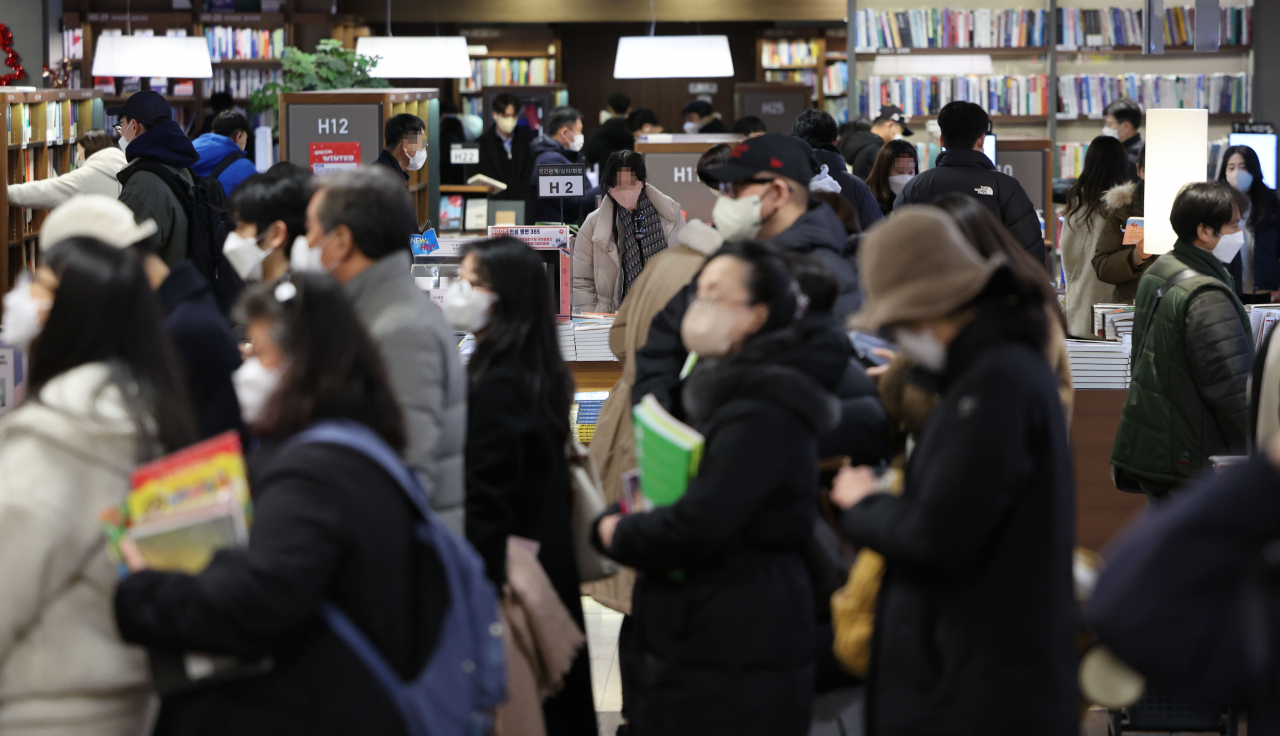 |
People are seen wearing face masks inside a book store in Seoul on Sunday. (Yonhap) |
South Korea's pandemic response authorities proposed on Wednesday to lift the nationwide indoor mask mandate as early as January next year, with plans for policy talks and forums beginning this month.
"As long as conditions (regarding the gravity of coronavirus) are met, (the eased mask rules) will come into effect at least in January, or March at the latest," Peck Kyong-ran, commissioner of the Korea Disease Control and Prevention Agency, said in a briefing in Seoul Wednesday.
Peck added the new rules will unlikely be applied to all buildings and facilities, so wearing a mask inside would remain in place for high-risk environments such as hospitals and senior care facilities.
The commissioner cited the reduced virulence of a COVID-19 pathogen, with immunity mainly due to vaccinations and infections, and so the reduced possibility of a sharp surge in infections. Over 65 percent of Korea's population has had three doses of a COVID-19 vaccine.
The remarks came immediately after Interior and Safety Minister Lee Sang-min revealed a final decision over the indoor mask mandate will be made before the end of this year.
The adjustment in the mandate will come with prudence, Lee added, given that coronavirus remains contagious in the nation, with the reproduction number standing above 1 for the past seven weeks. Lee, who chaired the Central Disaster and Safety Countermeasure Headquarters meeting in Seoul Wednesday, said the next meeting on Friday will start working on adjustments to the current rule.
The announcements are in line with indications people may no longer be fined for not wearing a mask indoors in areas such as restaurants, coffee shops and offices, amid disputes over the rule's efficacy. A violation of the indoor mask mandate is now punishable with a fine of up to 100,000 won ($76).
On Tuesday, Prime Minister Han Duck-soo in a briefing hinted at the eased mask rules, saying that certain conditions suggested by medical experts could be met to lift the mask mandate in January.
Jung Ki-suck, a top medical adviser of the Central Disaster and Safety Countermeasure Headquarters, echoed Han, saying lifting the mask mandate in January "sounds plausible" as he projected Korea will achieve hybrid immunity by then, an apparent U-turn from Monday's briefing that the premature decision to ease the mask rule could put those at risk in danger.
The indoor mask mandate has been considered one of the last remaining sanitary measures to curb the spread of the virus in Korea.
If the indoor mask mandate is adjusted, it will mark the end of a nationwide rule that has been in place since October 2020 -- beginning nine months after the country confirmed its first COVID-19 case.
In April 2022, Korea lifted its social distancing measures, which required shops and restaurants to limit the number of people inside as well as adhere to an early closing time. In May the outdoor mask mandate was removed, then in October the government removed testing and quarantine requirements for those traveling to Korea.
Local governments have sought to make autonomous decisions to ditch the indoor mask mandate over the past few days. South Chungcheong Province, home to 2.1 million people, was the latest to express such intention, while Daejeon city with 1.4 million people is looking to eliminate the mask mandate beginning in January, regardless of the nationwide rules in effect.
Interior Minister Lee, however, downplayed the possibility of a regional disparity in the indoor mask rule, and instead stressed a "uniformity in (COVID-19) preventive measures in the face of what would likely be the last winter wave."
According to the government, any easing of COVID-19 rules by the provincial and local governments must be done upon consultation with the Central Disaster and Safety Countermeasures Headquarters, while tightening mask rules can be done autonomously.
Meanwhile, the winter cold wave has led to a spike in infections over the past few days. On Wednesday, Korea saw 74,714 new daily cases of COVID-19, with total COVID infections reaching 27.48 million -- 53 percent of the population -- and the death toll reaching 30,847.







![[Today’s K-pop] Blackpink’s Jennie, Lisa invited to Coachella as solo acts](http://res.heraldm.com/phpwas/restmb_idxmake.php?idx=644&simg=/content/image/2024/11/21/20241121050099_0.jpg)